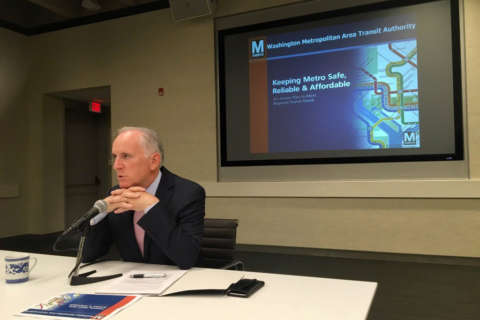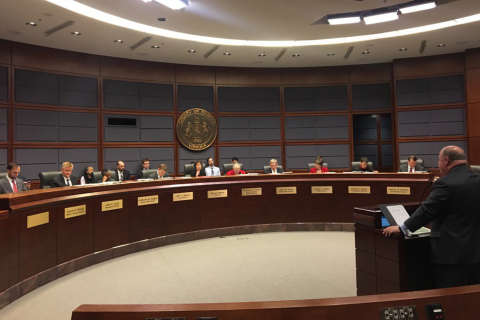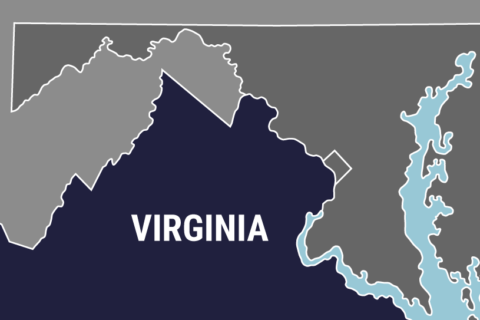WASHINGTON — A new 1 percent regionwide sales tax should be implemented in two years to cover Metro’s urgent capital funding needs, a panel of local leaders said Wednesday afternoon.
“Doing nothing is not acceptable,” said the Metropolitan Washington Council of Governments technical panel’s final report. But it acknowledged that the same urgent recommendations have been made before alongside similar dire warnings, and that nothing has changed.
“The Panel’s conclusion regarding the sales tax option is the same as one made in 2005,” the report said.
Now, Metro faces more than $15 billion in key needs over the next decade. Last week, Metro General Manager Paul Wiedefeld said that $15 billion in projects could be a realistic goal for upgrades and repairs in that time frame, but that an additional $10 billion in needs would need to be put off beyond that.
His proposal calls for $500 million a year in dedicated capital funding, which could be covered with the $650 million estimated revenue generated by the regional 1 percent sales tax that is proposed in this new report.
“A regional funding solution must be in place by no later than January 2019, as local governments cannot afford the steep bill for Metro’s needed capital and maintenance program while simultaneously financing their jurisdictional needs for schools and other critical infrastructure,” the technical panel report said.
A sales tax, the panel said, is “the best, most equitable revenue option.”
The technical panel comprises Metro’s chief financial officer and regional staff members, as well as city and county administrators from the District; Montgomery and Prince George’s counties in Maryland; and Loudoun, Fairfax and Arlington counties and Alexandria in Virginia.
The District’s Chief Financial Officer Jeffrey DeWitt presented the outlines of the idea in October to Maryland Gov. Larry Hogan, Virginia Gov. Terry McAuliffe and D.C. Mayor Muriel Bowser.
“It is a reasonable solution that spreads the cost widely, over the entire region, including tens of millions of annual visitors,” the report said. “It provides a stable funding source, well understood by investors to debt-finance substantial capital infrastructure needs at low interest rates. It is easily understood.”
“It’s important to remember that everyone benefits from Metro, whether you take it or not — everyone benefits from congestion relief; from the need for fewer roads, bridges, etc.; and from the environmental benefits,” it continued.
The panel did not seriously consider the possibility of levying property taxes around Metro stations (which would capture the additional value Metro brings to those properties). Initial estimates had suggested that to raise $650 million through special taxes on land within a half mile of Metro, tax rates would have to rise 43 cents per $100 of assessed value there.
To raise the money through a regionwide property tax increase, the panel estimates that property taxes would have to rise 8 cents per $100 of assessed value.
Similarly, the panel eliminated the suggestion of raising gas taxes to pay for Metro’s needs, because the panel believes raising regional gas taxes by 6 to 9 cents per gallon (16.3 percent) is not feasible.
“The Panel recommends that the COG Board take a serious look at proposing that D.C., Maryland and Virginia add to the general sales tax in all Metro Compact jurisdictions. It is not a perfect solution, but it comes closest to collecting revenue as if a regional taxing entity existed, and is an efficient and stable method to generate the revenue needed for Metro’s critical capital needs,” the report said.
What’s next
The Technical Panel recommended that the Council of Governments vote on the sales tax proposal in June, and coordinate with business groups and others reviewing various aspects of the Metro system.
Any action from the Council of Governments would not be binding on the region. But it could contribute to model legislation that Maryland and Virginia legislators could take up during their winter 2018 sessions and that the D.C. Council could take up no later than next spring.
In Maryland and Virginia, local governments cannot impose their own taxes unless the state has given the jurisdiction explicit permission, and the state legislatures are usually in session only in the winter and early spring.
If the general assemblies and the D.C. Council pass the legislation by next spring, the tax could begin in time to help cover costs for Metro’s budget year that starts July 1, 2018. That is when the panel and a number of regional leaders have warned that funding requests are slated to go beyond what the region can afford.
In Fairfax County’s case, the additional money over 10 years would likely be $1.1 billion. State funding in Virginia is also at risk, with statewide transit capital funds set to be dramatically reduced next year unless the General Assembly takes separate action.
The dedicated tax could be used to back bonds for major long-term capital projects, with some additional money available for maintenance needs. The panel also recommends capping Metro’s spending growth at 3 percent per year, which Wiedefeld has now agreed to in principle.
The technical panel also emphasized the importance of maintaining federal funding for the Metro system.
Like Wiedefeld’s proposals for the region he outlined last week, the report is focused on finances, not other reforms to Metro’s governance structure. Other reviews, including one led by former U.S. Transportation Secretary Ray LaHood, are expected to outline additional proposed changes later this year.
“Metro has suffered from decades of delayed maintenance and insufficient capital investment, and must be provided the resources it needs to build on recent progress — to fully achieve a state of good repair and execute additional capital and maintenance projects essential for the long-term viability of the system,” the technical panel’s report said.
What you’d get from the tax
In exchange for imposing the tax, the report said the local governments would expect “tangible results” including:
- Metro will be an organization worthy of the region’s continued support and expanded investment.
- WMATA will be good stewards of their investment.
- Metro will manage an expanded budget that will help to rebuild trust with the region.
- Metrorail will be in a state of good repair.
- Metro will continue to enable economic growth in the region.
- Ongoing rehabilitation and replacement of track — to ensure reliable service and restore user confidence
- Replace nearly 600 older railcars
- Replace or rehabilitate approximately 240 escalators
- Rehabilitate approximately 100 elevators
- Replace or refurnish fare gates and fare boxes — to improve customer experience and provide greater accountability
- Replace or rehabilitate approximately 185 buses per year — to improve service and reliability
All of these recommendations and expectations are based on assumptions that are far from certain.
For one, the plans assume that federal funding for Metro and transit systems generally remains steady, even as President Donald Trump’s administration has suggested there could be cuts.
Secondly, the technical panel report assumes there are no labor cost increases in Metro’s fiscal year that starts July 1. Metro and its largest union, Amalgamated Transit Union Local 689, remain in contract talks after their previous agreement expired last June.
Third, the report assumes passenger fare revenue will grow by 3 percent each year starting in 2021 “from ridership and/or fare increases.”
Ridership has been declining for years, in large part due to Metro’s service issues.
“There has also been significant impact of reduced reliability in the form of lost productivity for Metro system users, estimated at [$51 million to $61 million] per year (2014-2015),” the technical panel report said. “And the cost of delay for 2015-2016 is preliminarily estimated at [$153 million to $253 million].”
If the region does not impose the new 1 percent sales tax on top of existing sales and use taxes, the panel warns, it would hurt the region’s economy and cut regional tax revenues for other purposes by more than $1 billion per year.
What’s covered?
Wiedefeld’s plan to fund Metro calls for $15.5 billion for the most significant capital needs, including railcars and parts ($3.3 billion), rail systems ($3 billion), track and structures ($2.1 billion), rider facilities and stations ($2.6 billion), bus and paratransit ($2.6 billion) and business support systems ($2 billion).
That tally does not include other critical capital projects that have been identified as key to safety or reliability.
Those additional projects are expected to cost up to $10 billion, and include improving tunnel ventilation systems to better deal with smoke incidents; a new tunnel at Rosslyn; finally fixing major water issues on the west side of the Red Line; increasing station capacity; and Metro’s office facility needs. Those could be funded later with remaining money available under the dedicated tax.
“A safe and reliable Metro system is fundamental to the long-term success of our region,” the report said. “The scope and scale of Metrorail’s infrastructure, long-term capital and maintenance funding needs require billions of dollars of investment. These problems are insurmountable in the absence of significant new funding — funding that faces competing priorities in the localities.
“It is not possible to close this gap through farebox revenue and cost- saving measures alone.”







